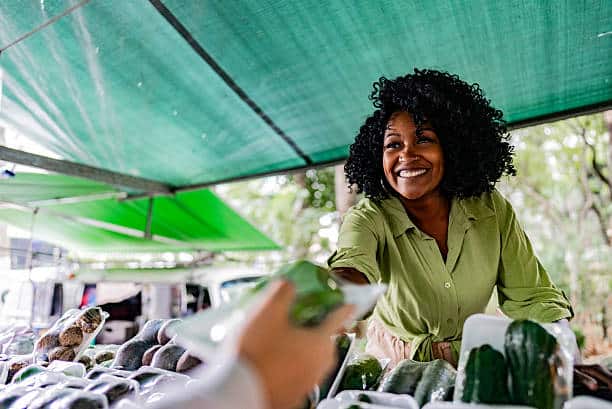
Eating healthy doesn’t have to break the bank.
As we move through summertime, all kinds of vibrant fruits, nutritious vegetables, and fresh flavors abound. But for many people, sadly, access to these amazing foods is limited. While organic, local, whole foods are best, not all people can get them.
For starters, the cost of organic groceries can feel like a barrier, especially when systemic economic disparities make budgeting a priority.
Fortunately, there’s good news. Affordable organic food is within reach; you just need to know where to look.
Ready to make it happen? Let’s break down all your options this summer of 2025, tailored to the precise needs of Black individuals and families.
6 Ways to Tackle Grocery Shopping on a Budget
1. Discount Grocers
If you’re seeking foods free of synthetic pesticides and fertilizers, discount grocery stores should be your first go-to. Because organic produce often costs 20-50 percent more than conventional options, affordability here is key.
So stay on budget! Discount grocers like Aldi, Lidl, and Trader Joe’s are all game-changers for affordable organic shopping. Many of these stores focus on private-label organic products, meaning the costs usually associated with ‘middlemen’ are gone. Also, there’s no need for flashy marketing that drives up prices.
What you get, instead, are nutritious and delicious foods at prices your pockets will savor too. Aldi in particular is a popular choice thanks to its Simply Nature brand, which provides fruits, vegetables, dairy, and pantry staples at prices often 30-40 percent lower than traditional supermarkets.
If you’re beginning your bargain shopping, don’t forget several important tips. Before you head out the door, check weekly ads for organic specials, especially seasonal produce. Make sure to also stock up on organic staples like rice, beans, and canned goods, which have long shelf lives. And finally, look into culturally relevant products, such as organic sweet potato snacks, to connect with your culinary roots.
RELATED: Healthy on a Budget: Grocery Hacks To Try This Weekend

2. Farmers’ Markets
Farmers’ markets are a summer treasure, giving you the best foods straight from your local producers. In 2025, many markets, especially in urban areas like Atlanta, Chicago, or D.C., will cater to Black communities. You’ll find vendors selling all kinds of goodies, such as organic collards, okra, and peaches. The prices can also be lower than in grocery stores, with organic tomatoes often two to three dollars per pound versus four to five dollars at supermarkets.
Even better news, many markets accept SNAP, WIC, and Senior Farmers’ Market Nutrition Program vouchers. Thanks to programs like Double-Up Food Bucks, you can even greatly increase your purchasing power for a ton of delicious produce.
For the best results, visit these markets later in the day for discounts, because many vendors lower prices to clear their inventories. And if you want to tune up your culinary skills, you can attend markets with cooking demos that show you how to get the most with the least.
Great food, inexpensive recipes, cultural connections to your roots – what’s not to love?

3. Warehouse Clubs
Warehouse clubs like Costco, Sam’s Club, and BJ’s Wholesale are ideal for families seeking organic food in bulk. At places like Costco, the Kirkland Signature organic line is especially attractive. You can get summer favorites like strawberries and spinach, all up to 30 percent cheaper per unit than traditional grocery stores.
Meanwhile, stores like Sam’s Club have you covered for meat, offering organic chicken and ground beef at lower per-pound prices, perfect for your summer barbecues. While membership fees are certainly an upfront cost, you can more than offset them if you’re a regular shopper.
Just make sure you’re on top of your habits. Split a membership with family or friends if you’re worried about costs, and don’t forget to freeze organic berries or greens to preserve them for year-round use. Organic versions of cultural staples, like quinoa and sweet potatoes, can spruce up your meals even more!

4. Online Grocery Stores
Online grocery platforms are lesser-known options – but that doesn’t make them any less useful!
Websites such as Misfits Market and Thrive Market are particularly helpful for people who can’t physically access quality whole foods. With these services, you can have organic food delivered to your door at discounted prices, whenever you want.
Interestingly, Misfits Market specializes in what it calls “ugly” organic produce—items rejected by supermarkets for appearance but just as nutritious. With these ugly offerings, you can get boxes of seasonal veggies and fruits as much as 50 percent less than retail.
Thrive Market is a little bit different and is actually a membership-based platform ($60/year). That said, you get access to many less common products, such as coconut oil and almond butter, as well as gluten-free and vegan-certified foods. Given their nationwide deliveries, these online grocers are a top choice for underserved communities, as well as high-powered professionals who are simply too busy.
So check them out! Take advantage of flexible subscriptions and customize your boxes for those seasonal goodies, like zucchini or watermelon. No more distant supermarkets, no more food deserts, no more one-size-fits-all. Get the curated options you want, and get them conveniently at a price that makes sense.
RELATED: Eating Well On A Budget: Nutritious & Affordable Food Choices For College Students
5. CSA Programs
If you haven’t heard of Community Supported Agriculture (CSA) programs, you’re not alone. In a nutshell, these programs allow you to buy a “share” of a farm’s harvest upfront. By doing this, you can then receive weekly or biweekly boxes of organic produce throughout the summer season.
It generally costs about $15-$25 per week, comparable to farmers’ market prices but with the convenience of a subscription. Programs like FRESHFARM’s Market Share in D.C. even cater to SNAP recipients, so if you’re struggling financially, you don’t have to worry!
Farms to Grow, Inc. is another great option, particularly focusing on Black farmers and their consumers.
Not sure where to start? Use LocalHarvest.org to find CSAs near you, and if possible, opt for work-share CSAs. These options allow you to volunteer a few hours to earn a discounted or free box. You can likewise split a CSA share with a friend or neighbor to keep the costs lower.
By capitalizing on CSAs and the other organic options presented in this article, you’ll be well on your way to healthier, tastier eating. Just do your best to plan ahead. Think seasonally, shop seasonally, and don’t be afraid to make connections online, like through the social media account @BlackFarmersHub.
If you budget smart and combine the various strategies outlined above, you’ll be surprised how healthily and inexpensively you can eat!









